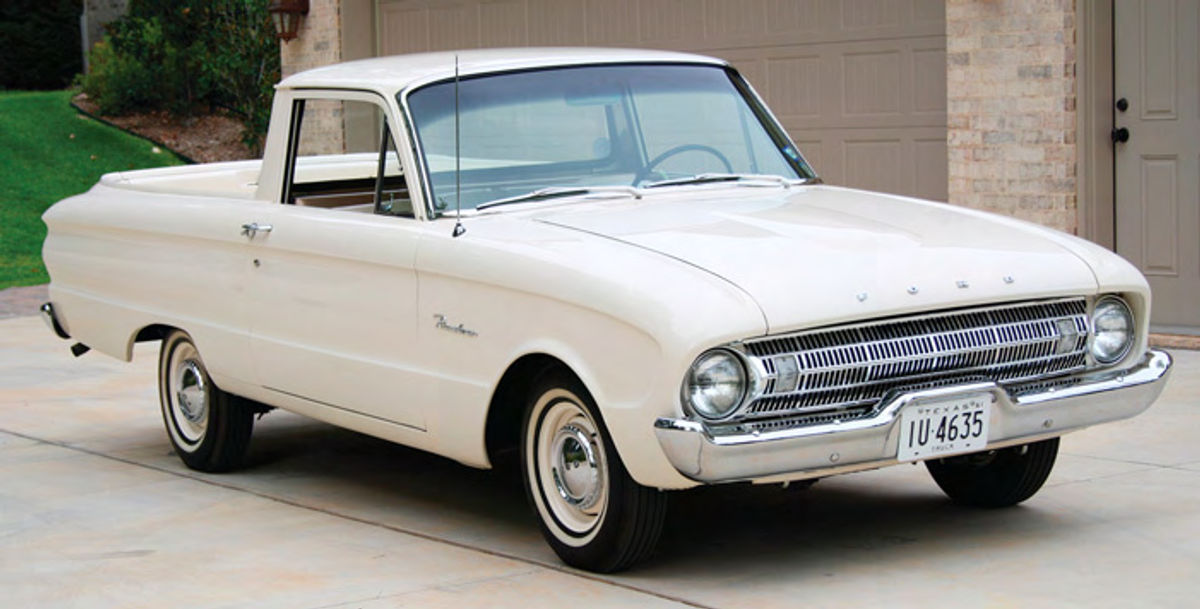1961 Ford Ranchero

His First Vehicle Was a Ranchero Like This One When He Was 15. He’s Replaced That Driver—for a Reasonable Price.
THE HISTORY OF the car-based truck dates back to the time of Ford’s Model T. That vehicle (as well as the succeeding Model A) served as the basis for a truck by placing a truck box behind a sedan body that was truncated behind the driver’s seat.
As you might expect, other companies moved into the market segment as well. Hudson introduced a Terraplane Utility Coupe for 1937, with Nash and Studebaker following with their versions soon thereafter. These vehicles were modified passenger cars with a retractable truck bed.
These adaptations of passenger cars generally offered the same comforts found in a conventional car while providing some significant cargo-carrying capability. Later, the market shifted to purpose-built half-ton pickups and the car-based truck was dropped from manufacturers’ lineups.
A Full-Size Ranchero at First
With a booming post-World War II economy, some families decided to buy a car and a truck. So the designing of trucks to have more car-like attributes became a priority—especially at General Motors which was the industry leader in styling and sales at that time. So GM’s managers must have been most unpleasantly surprised when Ford offered the Ranchero for the 1957 model year, the first postwar American car- based truck. GM had at least been working on the idea, as sketches of a 1955 Bel Air-based truck had been done at GM Styling. However, its Chevrolet El Camino didn’t enter the market until 1959.
The Ranchero, meanwhile, combined the styling of the big Ford with the utility of a light-duty pickup truck. Over 21,000 were built for 1957, but sales plunged the next year due in part to an economic recession. By the end of the ’59 model year, the Ranchero brought less than 14,200 orders.
Time to Downsize
In 1960 the Ranchero became a much smaller vehicle, built from Ford’s new compact model, the Falcon. Ford’s managers had become convinced potential buyers of the Ranchero wanted a much smaller, lighter and cheaper truck than a full-size pickup. Evidently they were right as sales rebounded for the new Falcon Ranchero. Annual sales amounted to approximately 21,000 units throughout the 1960-62 model years. For the 1963 model year, however, orders slipped to a little over 18,500. A redesigned Falcon for ’64 meant a redesigned Ranchero, but the sales slide continued; orders failed to reach the 10,000 mark that year and barely exceeded that figure the following year—the last for the Falcon-based Ranchero. For ’66, it was built from the freshly redesigned Fairlane. In 1968 it became aligned with the new Ford Torino and in 1977 it moved to the Thunderbird platform and shared features with the LTD II.
But with the market moving toward overall downsizing and government restrictions and requirements growing for car-based pickups, Ford decided to pull out of what had proven to be a minor sales segment and ended production of the Ranchero in 1979.
Back to the Feature
Aside from a new convex grille, the 1961 Ford Ranchero differed little in appearance from the 1960 model. The 1962 Ranchero received a facelift with a new vertical-bar grille and a dummy scoop in the hood bulge. Another new grille marked the ’63s.
The 1960 Falcon Ranchero’s standard engine was the 90 hp, 144 cid inline six- cylinder. For 1961, a 101 hp, 170 cid version was offered as an option and the 144 was re-rated at 85 hp. Two years later the 260 V-8 rated at 164 hp was offered as an option in addition to the standard 144 and the optional 170.
The two-speed Ford-O-Matic automatic transmission (offered between 1960 and 1963) could be ordered, while the standard offering was a three-speed manual transmission.
Other optional features included a heater/defroster, radio, and a safety package consisting of a padded dash, padded sun visors, and seat belts.
The owner of the 1961 Falcon Ranchero pictured here, Steve Shore of Longview, Texas, purchased it at the Pate Swap Meet in Ft. Worth in 2005. His main reason for the purchase was nostalgia; his first automobile was a ’61 Ranchero his father bought for him for $300 when Shore was 15 years old. “I had a lot of fun with that little truck and always wanted another one,” he said.
Just a Fix-Up Job (He Thought)
Upon inspecting the Ranchero, Shore judged it as being “in fairly good shape,” though it was not running. “Everything was there,” he said. “It had the original paint and interior, although neither was in good shape.” (The Ranchero came from Abilene, Texas, a relatively arid place which one would expect to help keep rust to a minimum.)
Shore’s plan was to “simply wash it and polish the original paint and then get it running—just make a fun driver out of it without putting too much money in it.”
As often is the case with a project,things did not go exactly as planned.
The Ranchero had been sitting under a tree for an extended period of time. Trees naturally attract birds so one can imagine the deposits—that tend to etch their way into paint—found on the exterior. Shore cleaned and polished the paint, but found it “to be too far gone.” It could not be made suitable for even a rough driver, he decided.
Then, when the interior was removed, Shore found the floor pans to be more rusted than he had expected.
“The Falcon, even though it lived most of its life in Abilene,still had a lot of rust as these old Falcons are prone to have,” he said. “Bottom line, this was going to be a full-blown restoration. Still, I intended that this would be a ‘budget’ restoration and for the most part it ended up being just that.”
Body and Trim
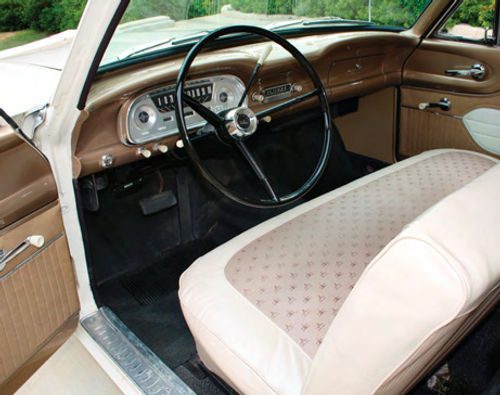
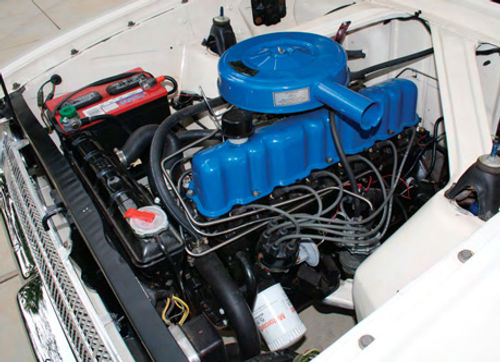
Shore stripped the Ranchero of its exterior trim, interior, and running gear which was accomplished “… in a matter of a few hours. There is not much interior to strip and the engine and transmission can be removed in less than an hour. Once stripped, I sandblasted the body myself at my place of business. From there I towed the car to a local body shop, Doug’s Paint & Body in White Oak. My instructions to Doug were to repair any body issues and then apply a good basecoat/clearcoat paint job. They did a fantastic job—the whole car—exterior and inner body and paint work were done for just over $5000.”
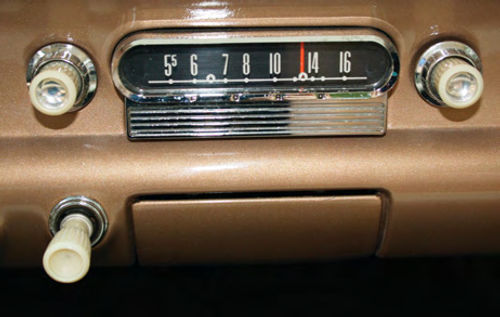
Left and right floor pans for the Ranchero are reproduced and are the same from 1960-65. The truck bed is not offered in reproduction form, but luckily Shore’s Ranchero only needed minor dent repair. No panels required patch- ing or replacement.
Doug’s Paint & Body disassembled the body and sandblasted away remaining rust in the floor pans. Minor dings and dents were knocked out and four coats of BASF RM two-part epoxy primer were sprayed on the body. This was followed by block sanding and then another two coats of primer.
Once the primer was smoothed, BASF white sealer was applied. Three coats of RM base coat and three coats of clear were then sprayed next. Block sanding began with 1000-grit sandpaper, then changed to 1500, and lastly 2000-grit was used to further refine the finish.
The final step was buffing the surface with 3M brand rubbing compound. The Speedliner brand of bedliner was sprayed on the interior floors to reduce road noise and exhaust heat. The underside was also undercoated and detailed.
There is not much trim on the Ranchero. The grille is aluminum; Shore tried cleaning the original one, but was unsatisfied with the results so he purchased an NOS replacement. The trim around the windshield and window glass is stainless steel which required only polishing to restore its chrome-like shine.
Windshields for the Falcon sedan and the Ranchero are the same as are the seals from 1960-65. The tail light lens and gasket is the same for 1960-61; they are reproduced and inexpensive. Other small and inexpensive reproduced exterior components include the windshield wiper pivot bezel and gasket set, steer head emblem (same 1960-63), fender- top ornaments (1961 only), door lock set (1960-63), outside rearview mirror and gasket, and the “Ranchero” script (the latter two items are identical 1960-65).
Reaching for More Power
The standard 144 six-cylinder for the featured Ranchero was rebuilt locally. However, the owner quickly found it to be severely lacking in power and “sounded like a sewing machine.”
Shore had a 200-cid inline six-cylinder short block from a ’65 model which had been in storage for 30+ years. It was soon rebuilt and replaced the original 144. Its additional horsepower (120 in stock form, while the 144 was rated at 85) made a significant difference in the Ranchero’s driving characteristics. A mild performance camshaft and exhaust port divider, and a two-inch exhaust system boosted the output of the 200 engine.
Meanwhile, to keep the engine compartment appearance seemingly stock, Shore removed the PCV valve setup and installed the draft tube from the 144; the 144’s valve cover also was used. The original air cleaner from the 144 was replaced with one from an early 200; the 144’s was held in place with a clamp at the base while a stud and wing nut secure the 200 type. Furthermore, decals for the 144 were attached following the original layout. About the only other way to visually detect the engine swap is to count the number of core plugs—the 144 has three while the 200 has five.
If Shore had not already had a 200 six-cylinder readily available, he could have had the original 144 modified for improved performance. The basic 144 received multiple displacement changes over time growing to 170, then 200, and finally 250 cubic inches through bore and stroke alterations. Beginning in model year 1962 the Falcon’s 144/170 sixes had seven main bearings rather than four. The 200 arrived for ’64 as an option for the Mustang then for ’65 was made available for the Falcon series. Furthermore, Ford offered the six-cylinder in 240- and 300-cubic-inch versions for full-size cars, trucks and vans. The 300 continued to be produced by Ford until 1997; it was fuel-injected and would offer excellent performance if such an engine swap was deemed suitable by a restorer. Aftermarket two-barrel carburetors are available for the Ford sixes of this era.
Many Other Reproductions Are Available
Stopping is at least as important as accelerating and cruising. Fortunately, parts are as readily available for the braking system of the Falcon Ranchero as are the engine parts. Brake drums, front and rear, are available through various auto parts stores and vintage car parts suppliers as are wheel cylinders, brake hoses and shoes.
Suspension parts are no problem to obtain either. Complete kits can be obtained through Kanter Auto Products.
The ignition switch, ignition wiring harness, and ignition switch bezel are all reproduced. Incidentally, Pertronix offers a 40,000-volt coil and electronic ignition if you want to do away with the point and condenser set. Shore did switch to the Pertronix system during the restoration.
Other reproduced components include the headlight switch, turn signal cam, horn contacts, brake light switch, door jamb switches, headlight dimmer switch, and the neutral safety switch (for automatic transmission vehicles only).
The fuel tank, though, can be a problem for the restorer as it does not appear to be reproduced for the Ranchero; those for Falcon passenger cars will not fit. However, items such as the fuel sending unit (1960-64 the same) and the fuel filler hose (1960-63 the same) are reproduced. Repairing the original fuel tank or finding a good or repairable fuel tank currently are the only solutions for dealing with a rusty one. Shore was able to reuse the original from his vehicle by having it cleaned and coated inside to prevent new rust from forming.
Interior
The Ranchero’s interior is straightforward, bordering on simplistic. Without power accessories (i.e., power windows and seats) or air conditioning, everything in the dash is easily accessible. Furthermore, it has a single bench seat and a small cabin.
Even with the simple nature of this particular model, however, there are a couple of problems faced by a restorer when the vehicle’s rubber floor covering and door panels need replacement. The rubber mat is not reproduced—at least not yet—and the same is true for the door panels.
Shore was fortunate to acquire an NOS floor mat on eBay, but its advanced age made its installation somewhat difficult because the rubber could easily be torn in the process. A slow and careful pace kept that problem to a minimum.
However, an alternative is offered by Falcon parts providers in the form of a carpet in black, blue, brown, red and turquoise. Original Falcon Interiors supplied the upholstery and reproduction door panels; however, the panels are not an exact reproduction of the ’61 Ranchero’s original components.
All Falcons of this model year shared the front door panels so if a Ranchero restorer found a Falcon parts car with nice front door panels they could be used. Door panel clips, which are also reproduced, are the same for model years 1960 to 1963. A padded dash (the same for 1960-63) was offered as an option and this is available as a reproduction in black only.
Other interior components offered in reproduction form include the headliner, windlace, defroster ducting, knobs for the headlight switch, windshield wiper, heater fan, radio, cigar lighter, turn signal lever, and the dome light lens and bezel (which differ from the passenger car type).
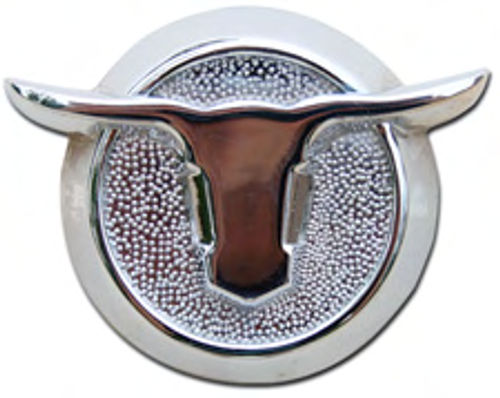
A Nice Driver
Once the 200 six-cylinder was installed, Shore’s Ranchero became more enjoyable to drive. And upon seeing the vehicle, one could reasonably assume that a great deal more than $10,000 was spent on the restoration of this compact Ford truck.
Evidently, the secret to a low-budget restoration project is deciding on a relatively simple vehicle like the Falcon series and then finding one which does not need significant rust repair. Performing as much of the work as you can your- self obviously reduces the dollar cost of a restoration, too.
These Falcons have not soared in value like many other automobiles of the ’60s, so restoring a basket case most certainly would call for the spending of far more money than the final product would be worth at resale.
But as shown here, buying one at a reasonable price and picking an example that needs only a minimal amount of body work puts the model into the reach of the average restorer. And some folks say the Falcon Ranchero can be as nice a driver as the original Mustang, but with a lower price tag.
Resources Clubs Falcon Club of America
P.O. Box 113
Jacksonville, AR 72078-0113 falconclub.com/
Parts:
Falcon Enterprises
3429 Freedom Park Drive #19 North Highlands, CA 95660
Kanter Auto Products
76 Monroe St.
Boonton, NJ 07005
Original Falcon Interiors
6343 Seaview Ave. NW Seattle, WA 98107-2664


